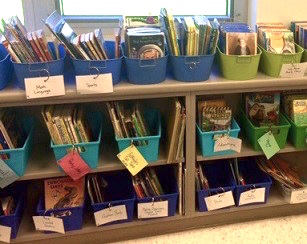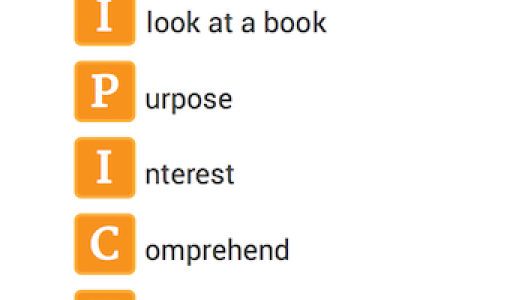I PICK Reader's Theater
Join Our Community
Access this resource now. Get up to three resources every month for free.
Choose from thousands of articles, lessons, guides, videos, and printables.
 It’s the beginning of a new year—a great time to review all the routines and procedures that have kept your classroom running so smoothly these last few months. During quick book-box checks and conferences, you probably reinforce the importance of reading good-fit books on a regular basis. Today it is your students’ turn to do the same for their peers. Here is a reader’s theater script that will remind students to use I PICK (Boushey & Moser, 2014), whenever they choose a new book.
It’s the beginning of a new year—a great time to review all the routines and procedures that have kept your classroom running so smoothly these last few months. During quick book-box checks and conferences, you probably reinforce the importance of reading good-fit books on a regular basis. Today it is your students’ turn to do the same for their peers. Here is a reader’s theater script that will remind students to use I PICK (Boushey & Moser, 2014), whenever they choose a new book.
They can perform this reader’s theater script for their own class, or take it “on the road” to share with other classrooms in your school. A parent open house or literacy night might offer another venue for an award-winning quality performance from your class.
I PICK
(Readers: Narrator and Students 1–4; the entire class will have the opportunity to participate at the end. Props: Five large cards with letters that form the term I PICK, and a notebook and pen for Student 3.)
Narrator: Thanks for joining us today for a fun way to review I PICK with our classmates. Let’s listen in as students talk about the best way to find a good-fit book.
Student 1: Today is library day.
Student 2: I just love library day! There are so many books I can choose from!
Student 3: Well, for me, that’s the problem. There are s-o-o many to choose from, and I don’t know which ones to check out. If I make a wrong choice, I have to wait till next week to try again.
Student 1: I know what you mean. Sometimes I get a book out, and I find that I don’t really like it. Or maybe it’s too hard. I don’t get what I’m reading.
Student 4: I think I can help. You’re heard of I PICK, haven’t you?
Student 3: I’ve heard of it, but I’ve forgotten what it means.
Student 2: Wait! I remember! I PICK is a great way to remember how to choose a good-fit book. Each letter stands for something important about choosing a good-fit book, one that I can understand and read because I know most of the words.
Student 4: Every week, I use I PICK when I go to the library. The letter I stands for “I look at a book.” Before I check a book out of the library, I look at the cover, the inside blurb, and the back cover, too. It gives me information about the book. P stands for “purpose,” or the reason I want to read a book. The next letter I stands for “interest,” or whether I like the topic. The letter C stands for “comprehend,” and the letter K is for “know the words.”
Student 2: So, if I look at the cover and think the book looks interesting, I go on to the next step. I check that the book meets my purpose. That means that if I have to write a report about an animal, I’ll choose a nonfiction book instead of a fiction one, because it meets my purpose. I have to be interested in the topic, too. For example, I’ve always been curious about elephants, but I really don’t like monkeys. So, when I go to the library, a book about elephants will be the one for me! Before I decide to check a book out, I read a few sentences to be sure that I comprehend it. Last of all, I look to see that I know most of the words.
Student 3: Maybe I’ll pick the same book that you do at the library today.
Student 2: I’m flattered that you want to read the same book, but that may not be a good idea.
Student 3: Why not? You said that you have this great method of choosing books.
Student 2: Well, a good-fit book for me might not be the best choice for another reader, and vice versa. We probably have different purposes for reading and like different things. I might understand the book, but maybe the other reader won’t. Do you see what I mean?
Student 3: Yes, I get it. All readers have their own good-fit books.
Student 1: That’s true. I tried to read my sister’s favorite book, but I just didn’t like it. I got frustrated because it was way too hard.
Student 3: Does I PICK really work?
Students 2 and 4 together: It sure does!
Student 1: Today I am going to use I PICK. That way, I will be able to enjoy my book instead of just letting it sit in my book box all week.
Student 3: Me, too! Let me write what I PICK means again (pretends to write in notebook) so that I will remember.
Audience-Participation Time
Narrator: Now it’s audience-participation time. Let’s review how everyone can find a good-fit book.
Student 1: I have cards with the letters that spell out I PICK.
Narrator: Great! Raise your hand if you want to volunteer. (Selects volunteers.) Volunteers, please come to the front of the room. Now arrange the letters in order to form I PICK. First, please tell what each letter stands for. Then you can call on another classmate who raises his or her hand to explain why it is an important part of I PICK. (Alternative approach: students can turn and talk to a partner about the significance of each part of I PICK.)
Students 1, 2, 3, 4, together—after the I-PICK review is finished: Thanks for reviewing the way to select good-fit books with us. Remember to stick with I PICK!
Note to Teachers: You can incorporate this script as part of your Daily 5 rotations; for example, if it is a good fit, students can enjoy it during Read to Self. They can also practice it with a partner for Read to Someone. Your student actors and actresses might also make a tape recording of the reader’s theater to share for Listen to Reading. Or, you can challenge them to “Tune In to Interesting Words” and list some during Word Work. During Work on Writing, you can encourage them to compose their own reader’s theater about one of the Dailies, building stamina, working toward a CAFE Menu goal, and more!
Reference:
Boushey, G., & Moser, J. (2014). The daily 5 (2nd ed.). Portland, ME: Stenhouse.







